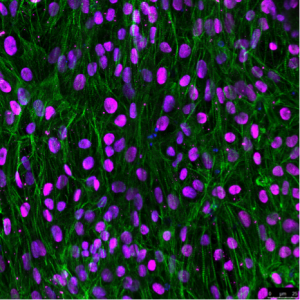Image: Cardiac differentiation of human pluripotent stem cell-derived cardiomyocytes on decellularized ventricular extracellular matrices.
They then used genome-editing techniques on human pluripotent stem cells (hPSCs) – undifferentiated cells from which other cell types develop – to efficiently produce cardiomyocytes, or heart cells, which they then used to repopulate the extracellular matrices of the decellularized human ventricles. Pluripotent stem cells are crucial for this process, as the body is not able to generate new cardiomyocytes after heart attack or other damage.
The cells within decellularized human heart matrices showed a higher degree of physiological and molecular cardiac differentiation compared to those cultured on regular tissue culture plates, which has been the usual method up to now. It took just 24 days for these human cardiac grafts to exhibit the correct electrophysiological responses needed in cardiac function; in other words, similarly beating as a heart does.
This type of de- and recellularization of organs represents a promising strategy for the development of biofunctional organs for drug screening and personalized medicine.

“Decellularization of a whole heart can lead to hundreds of acellular slices ready to use as scaffolds for the approach described here,” says Nuria Montserrat from IBEC, one of the three leading authors on the paper. “We anticipate that our fast procedure can be immediately applied in laboratories for cardiac engineering and disease modeling applied to humans.”
The work, which involved researchers from IBEC and the Hospital General Universitario Gregorio Marañón in Spain, as well as the University of Minnesota, the Texas Heart Institute, and the Salk Institute for Biological Studies in the USA, was supported in part by a European Research Council grant. It opens the door to advances towards achieving bio-artificial hearts populated by patients’ own stem cells.
—
Source article: Elena Garreta, Lorena de Oñate, M. Eugenia Fernández-Santos, Roger Oria, Carolina Tarantino, Andreu M. Climent, Andrés Marco, Mireia Samitier, Elena Martínez, Maria Valls-Margarit, Rafael Matesanz, Doris A. Taylor, Francisco Fernández-Avilés, Juan Carlos Izpisua Belmonte & Nuria Montserrat (2016). Myocardial commitment from human pluripotent stem cells: Rapid production of human heart grafts. Biomaterials, 98, 64-78
—
IBEC in the media:
La Vanguardia, “Crean injertos de corazón a partir de células madre en menos de un mes”
La Razón, “Crean injertos de corazón con células madre”
Diario Médico, “Crean injertos de corazón a partir de células madre”
Agencia SINC, “Injertos de corazón funcionales a partir de células madre pluripotentes humanas”
Huelva Información, “Injertos de corazón funcionales a partir de células madre”
El Día de Córdoba, “Injertos de corazón funcionales a partir de células madre”
Málaga Hoy, “Injertos de corazón funcionales a partir de células madre”
Diario de Cádiz, “Injertos de corazón funcionales a partir de células madre”
Diaro de Sevilla, “Injertos de corazón funcionales a partir de células madre”





